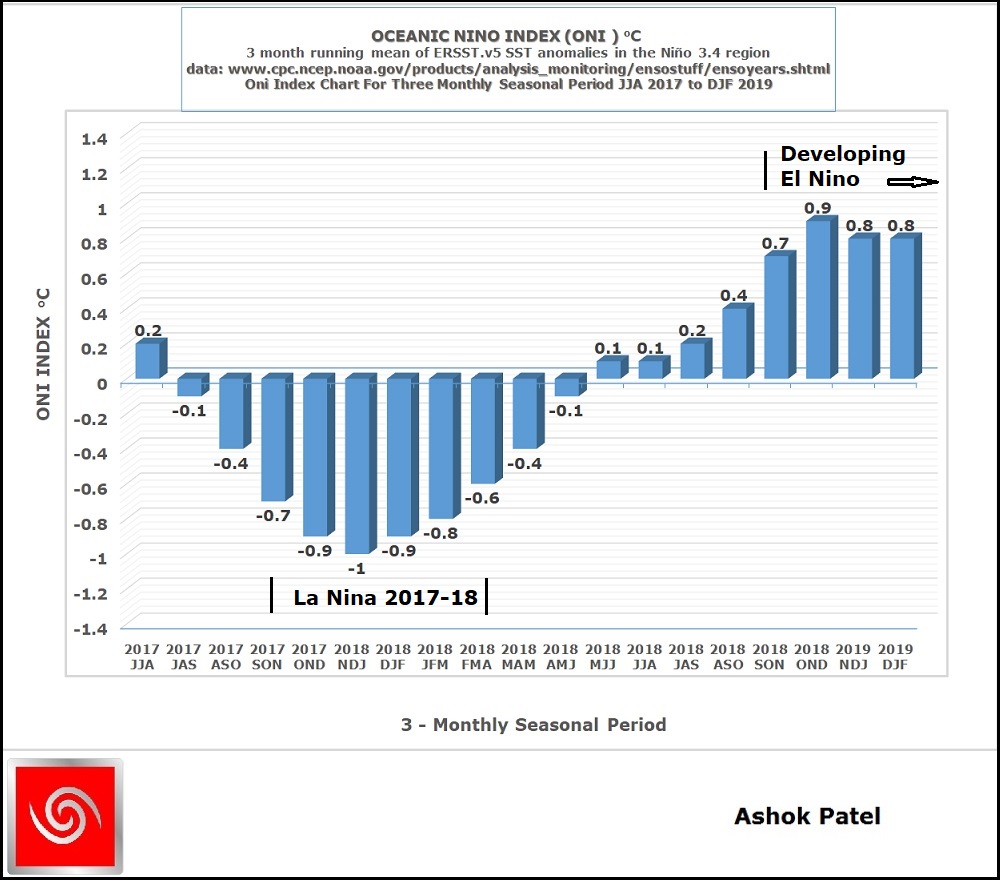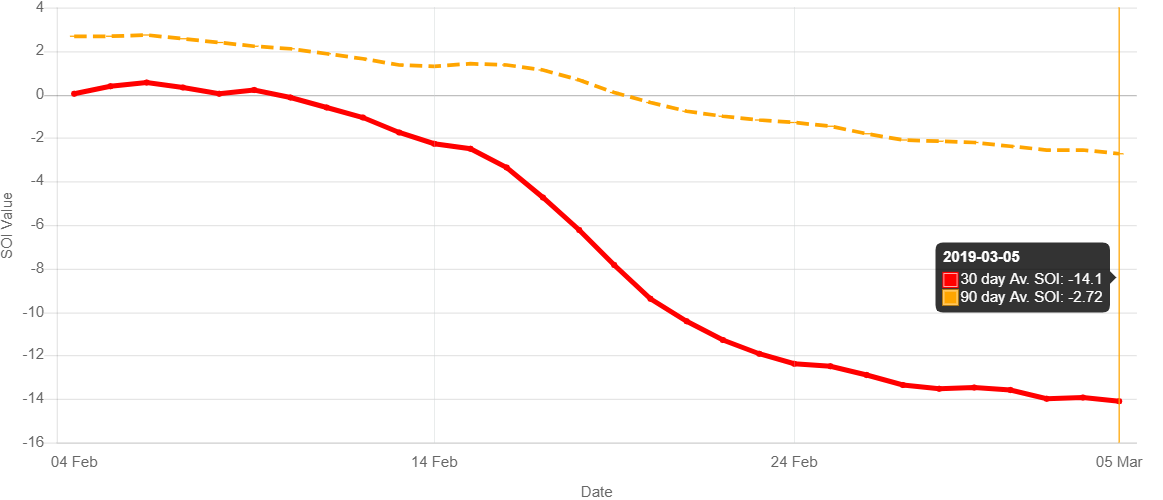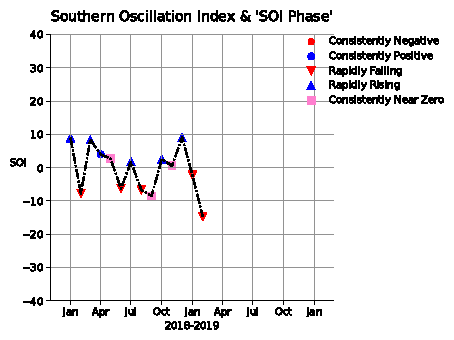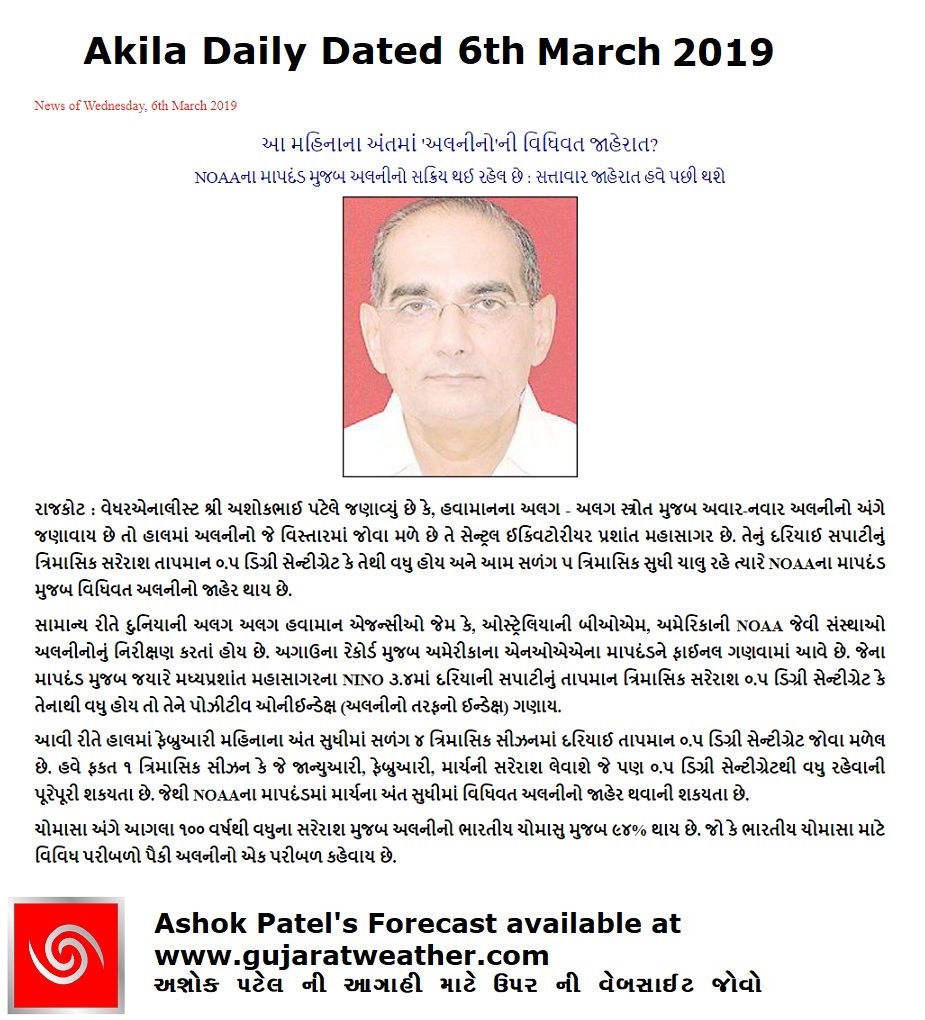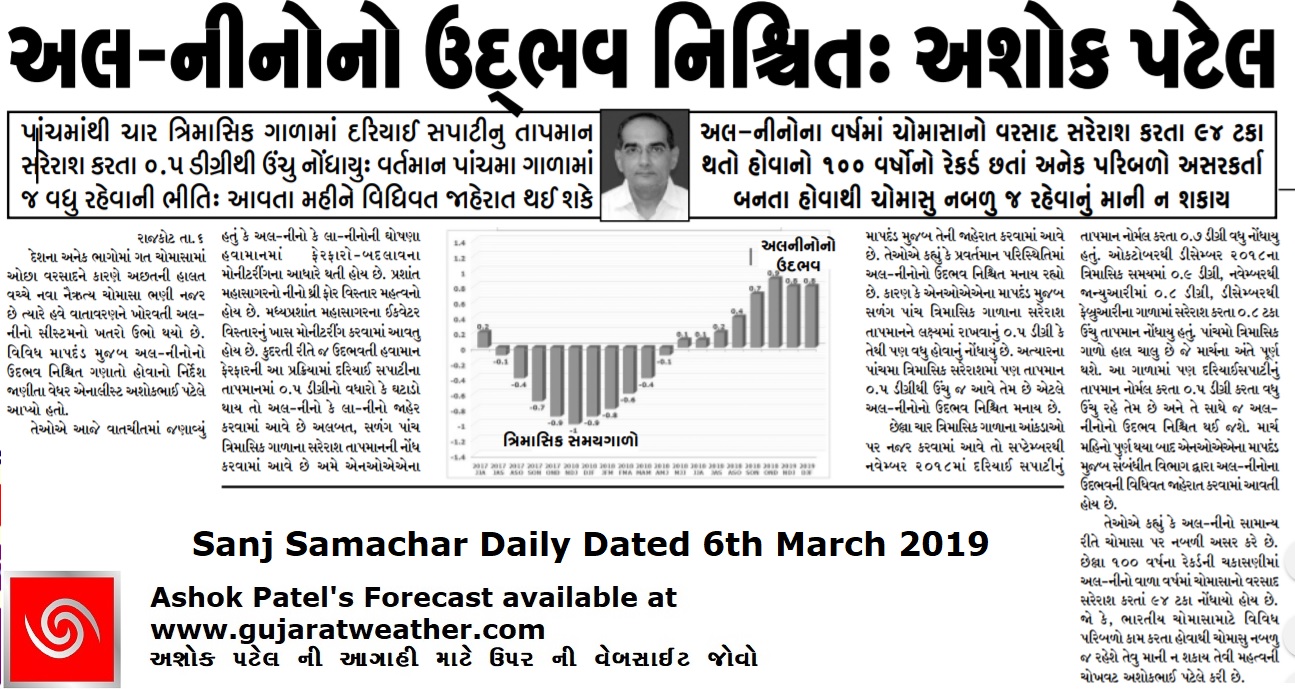Enso Status on 5th March 2019
El Nino is expected to be declared at the end of March 2019 as per NOAA criteria. Currently the developing phase of El Nino 2018-19 continues since already four consecutive 3-monthly seasons have had ONI greater than or equal to +0.5ºC.
Ashok Patel’s Analysis & Commentary :
Using NOAA Criteria, a full-fledged El Nino event expected to start at the end of March 2019 since already four consecutive overlapping 3-monthly seasons have had ONI of greater than or equal to +0.5ºC. The fifth 3-monthly season of JFM 2019 is also expected to be greater than or equal to +0.5ºC, thereby a El Nino will be declared.
With DJF 2019 ONI at +0.8ºC, a total of Four consecutive overlapping 3-month seasons have positive ONI greater than or equal to +0.5ºC. By historical standards, to be classified as a full-fledged El Niño JFM 2019 ONI needs to be greater than or equal to +0.5ºC. The JFM 2019 ONI will be calculated from Nino3.4 SST anomaly for January at +0.76ºC and February at +0.78ºC and so even if March SST anomaly stands at +0.0ºC, yet the JFM 2019 ONI will remain greater than or equal to +0.5ºC. A weak El Nino will be declared as per NOAA criteria at the end of March 2019, having fulfilled by then the five consecutive overlapping 3-month seasons with ONI greater than or equal to +0.5ºC.
Based on earlier more than 100 years weather Data for Indian Summer Monsoon, The Average Rainfall in an El Nino years is 94% of LPA while in La Nina Years it has been 106 % of LPA. El Nino or La Nina may affect the Monsoon differently for different Regions of India, however, that information is not available.
અશોક પટેલ નું તારણ અને વિશ્લેષણ :
NOAA માપદંડ મુજબ માર્ચ આખર માં વિધિવત ‘એલ નિનો’ થવાની શક્યતા છે કારણ કે છેલ્લા ચાર સળંગ અંશતઃ ઢાંકેલ ત્રી-માસિક સીઝન નું ONI ઈન્ડેક્સ +0.5ºC અથવા વધુ રહેલ છે. પાંચમું ત્રી-માસિક સીઝન JFM 2019 નું ONI ઈન્ડેક્સ પણ +0.5°C કે તેથી વધુ રહેવાની પુરી શક્યતા છે, જેથી ‘એલ નિનો’ વિધિવત પ્રસ્થાપિત થશે.
છેલ્લા બે મહિના નું Nino3.4 SST ઍનોમલી જાન્યુઆરી +0.76ºC અને ફેબ્રુઆરી +0.78ºC છે. માર્ચ 2019 નું SST +0.0ºC રહે તો પણ JFM 2019 નું ONI +0.5ºC થી વધુ કે બરોબર રહેશે. એટલે NOAA ના માપદંડ મુજબ માર્ચ આખર માં વિધિવત ‘એલ નિનો’ થવાની સંપૂર્ણ શક્યતા છે.
આગળ ના 100 વર્ષ થી વધુ ની શરેરાશ પ્રમાણે એલ નિનો વર્ષ માં ભારતીય ચોમાસુ 94% રહેલ છે, જયારે લા નિના વર્ષ માં ચોમાસુ 106% રહેલ છે. ભારતીય ચોમાસા માટે વિવિદ્ધ પરિબળો પૈકી નું એલ નિનો/લા નિના ફક્ત એક પરિબળ છે. ભારત ના અલગ અલગ વિસ્તારો ના ચોમાસા પર એલ નિનો/લા નિના ની અસર ઓછા વધતી થાય છે કે કેમ તે માહિતી હજુ ઉપલબદ્ધ નથી.
How ONI is determined:
The ONI is based on SST departures from average in the Niño 3.4 region, and is a principal measure for monitoring, assessing, and predicting ENSO. Defined as the three-month running-mean SST departures in the Niño 3.4 region. Departures are based on a set of further improved homogeneous historical SST analyses (Extended Reconstructed SST – ERSST.v5). Explanation about ERSST.v5 is given here.
The SST reconstruction methodology is described in Huang et al., 2015, J. Climate, vol. 28, 911-930.
CPC uses current Climatology based on 1986-2015 which has been changed late last year from base years 1981-2010. Explanation about Climatology base years change is given here.
NOAA Operational Definitions for El Niño and La Niña, El Niño: characterized by a positive ONI greater than or equal to +0.5ºC. La Niña: characterized by a negative ONI less than or equal to -0.5ºC. By historical standards, to be classified as a full-fledged El Niño or La Niña episode, these thresholds must be exceeded for a period of at least 5 consecutive overlapping 3-month seasons.
CPC considers El Niño or La Niña conditions to occur when the monthly Niño3.4 OISST departures meet or exceed +/- 0.5ºC along with consistent atmospheric features. These anomalies must also be forecast to persist for 3 consecutive months.
The Climate Prediction Center (CPC) is a United States Federal Agency that is one of the NECP, which are a part of the NOAA
Last five ONI Index are ASO 2018 +0.4ºC, SON 2018 +0.7ºC, OND 2018 +0.9ºC, NDJ 2019 +0.8ºC and DJF 2019 +0.8ºC. Latest Nino 3.4 SST is +0.78ºC. Hence, four consecutive overlapping 3-month seasons have had a positive ONI greater than or equal to +0.5ºC. By historical standards, to be classified as a full-fledged El Niño JFM 2019 ONI needs to be greater than or equal to +0.5ºC. The JFM 2019 ONI will be calculated from Nino3.4 SST anomaly for January at +0.76ºC and February at +0.78ºC and so even if March SST anomaly stands at +0.0ºC, yet the JFM 2019 ONI will remain greater than or equal to +0.5ºC. An El Nino will be declared as per NOAA criteria at the end of March 2019, having fulfilled then the five consecutive overlapping 3-month seasons with ONI greater than or equal to +0.5ºC.
Latest Oceanic Nino Index Graph Shows
Four Consecutive Overlappng 3-monthly Seasons Having ONI Greater Than +0.5ºC
The Table below shows the monthly SST of Nino3.4 Region and the Climate adjusted normal SST and SST anomaly for last two years. Climate Base 1986-2015. ERSST.v5
Period Nino3.4 ClimAdjust YR MON Temp.ºC Temp.ºC ANOM ºC 2017 2 26.68 26.66 0.02 2017 3 27.33 27.21 0.12 2017 4 28.04 27.73 0.30 2017 5 28.30 27.85 0.45 2017 6 28.06 27.65 0.41 2017 7 27.54 27.26 0.28 2017 8 26.70 26.91 -0.21 2017 9 26.29 26.80 -0.51 2017 10 26.15 26.75 -0.60 2017 11 25.74 26.75 -1.01 2017 12 25.62 26.65 -1.04 2018 1 25.58 26.45 -0.88 2018 2 25.98 26.66 -0.68 2018 3 26.50 27.21 -0.71 2018 4 27.32 27.73 -0.41 2018 5 27.74 27.85 -0.11 2018 6 27.76 27.65 0.13 2018 7 27.42 27.26 0.16 2018 8 26.94 26.91 0.04 2018 9 27.19 26.80 0.39 2018 10 27.62 26.75 0.86 2018 11 27.61 26.75 0.86 2018 12 27.49 26.65 0.84 2019 1 27.21 26.45 0.76 2019 2 27.45 26.66 0.78
Southern Oscillation Index
As per BOM, Australia:
The 30-day Southern Oscillation Index (SOI) to 3rd March 2019 was -12.5 and is in the El Nino range.
Sustained negative values of the SOI below −7 typically indicate El Niño while sustained positive values above +7 typically indicate La Niña. Values between +7 and −7 generally indicate neutral conditions.
Recent (preliminary) Southern Oscillation Index values as per The Long Paddock – Queensland Government.
30 Days average SOI was -14.62 at the end of February 2019 and was -14.1 on 5th March 2019 as per The Long Paddock – Queensland Government and 90 Days average SOI was -2.72.
SOI Monthly graph up to February 2019 as per The Long Paddock – Queensland Government.
Summary by: Climate Prediction Center / NCEP Dated 4th March 2019
ENSO Alert System Status: El Niño Advisory
El Niño conditions are present.*
Equatorial sea surface temperatures (SSTs) are above average across most of the Pacific Ocean.
The pattern of anomalous convection and winds are consistent with El Niño. Weak El Niño conditions are expected to continue through the Northern
Hemisphere spring 2019 (~55% chance).*
* Note: These statements are updated once a month (2nd Thursday of each month) in association
with the ENSO Diagnostics Discussion, which can be found by clicking here.
As per BOM – Australia 31st July 2018
ENSO outlooks
Five of the eight surveyed climate models predict sea surface temperatures (SSTs) at or above El Niño thresholds for March. Four of the models anticipate SSTs will remain above El Niño thresholds until at least July.
While three models anticipate a decline in SSTs over autumn and early winter, the majority of models indicate SSTs are likely to remain similar to current values or will see further warming of Pacific surface waters.
It should be noted that model accuracy forecasting through the autumn months is lower than at other times of the year, due to the natural cycle of ENSO, and this may be contributing to the difference in outlooks across the models. Outlooks skill improves for outlooks issued from May.
(Note: winter/spring is with reference to Southern Hemisphere)
All earlier updates are listed below:
Click here for Update “Much Hyped El Nino Has Not And Will Not Materialize During Indian Summer Monsoon 2018 “
Click here for Update “ENSO Neutral Conditions Prevail July 2018”
Click here for Update “Full-fledged El Nino Ruled Out During Southwest Monsoon 2018”
Click here for Update “Weak La Nina Exists Till The End Of April 2018”
Click here for Update “Full Fledged La Nina Event Has Developed At The End Of March 2018”
